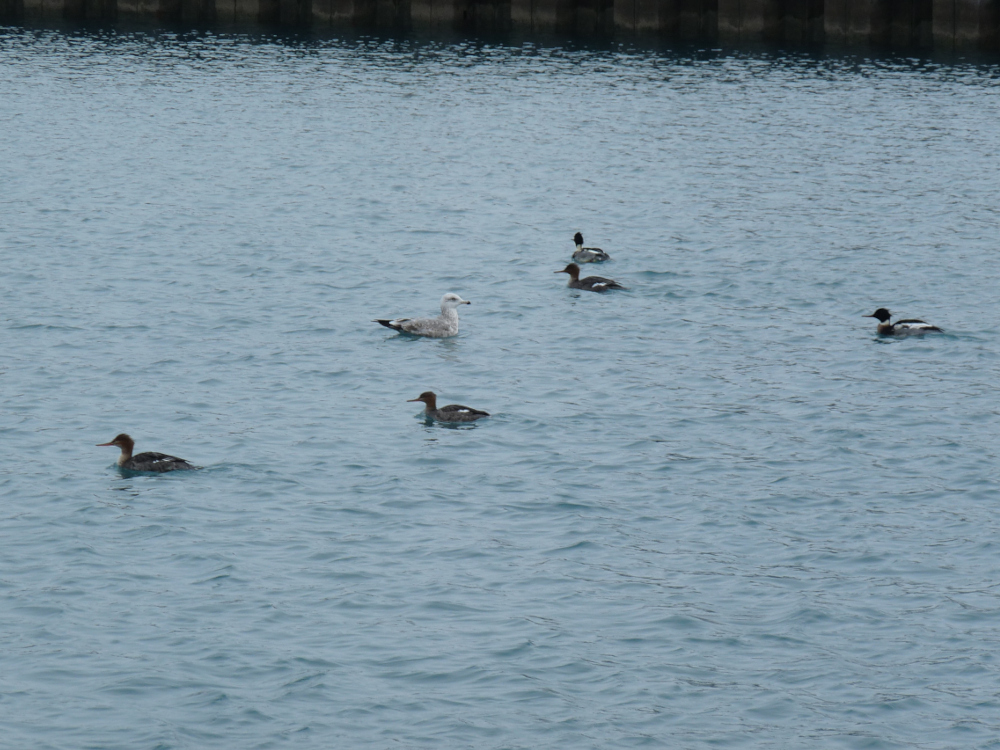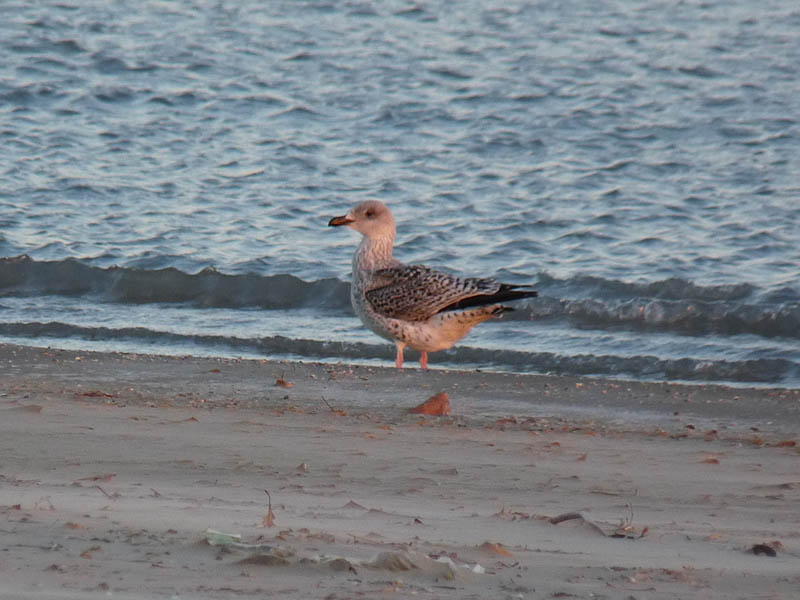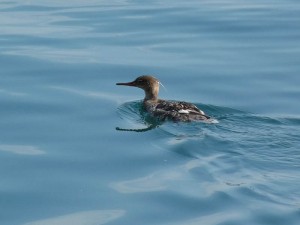One of the most distinctive sounds of spring at Montrose is the firing of fishing lines. Fishermen use fire extinguishers fitted with a pipe to propel their lines out into Lake Michigan. This setup functions like a canon, and the sound it makes is loud enough to startle you if you’re nearby. I’ve also noticed how close some waterbirds come to these fishing lines. I’ve seen Horned Grebes, Red-breasted Mergansers, and a Common Loon on one occasion swim right up to the lines. These birds may have been curious and looking for an easy meal. I can imagine a grebe or merganser getting tangled or grabbing the baited hook, which would be a mess for the fisherman and the bird. A tangled and thrashing Common Loon would be a worst case scenario. Loons are big enough and strong enough to do serious damage to a human trying to free them. They have sharp bills that can draw blood or poke out an eye. My guess is that fishermen would cut the line and lose their bait rather than try to free a struggling bird.
Tag Archives: Red-breasted Merganser
Kleptoparasitism – Stealing Does a Bird Good
You may have noticed Herring Gulls hanging around groups of Red-breasted Mergansers at Montrose. The gulls are there for a good reason, at least for them – to steal fish the mergansers have caught. When a merganser dives and then surfaces with a fish, the Herring Gulls race in and try to snatch it. Sometimes it works and sometimes it doesn’t, but the gulls must succeed enough to justify the effort. This thieving behavior is called kleptoparasitism and is a common practice where mergansers and Herring Gulls occur together. It’s easier for the gulls to let the mergs do the hard work of finding food and try to steal it then to catch the fish themselves. No one ever said nature was fair or just.
Open Water Means Life
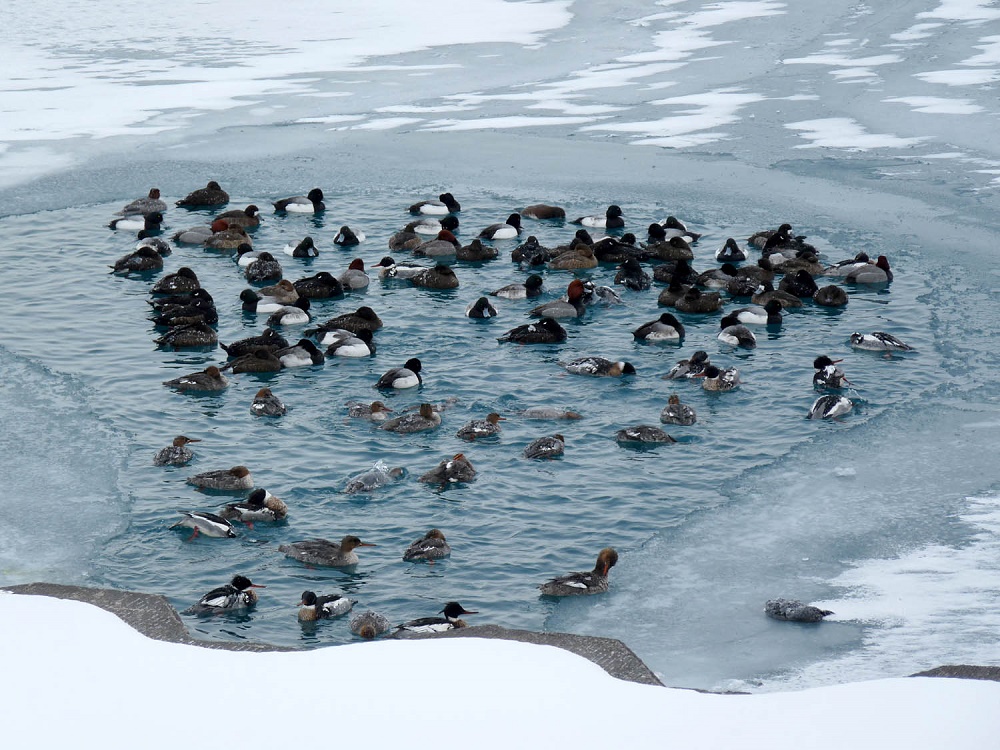
White-winged Scoters, Red-breasted Mergansers, and Greater Scaup. March 2014. (click to see the larger version)
Lake Michigan is a huge body of water. At 300 miles long and almost 120 miles at its widest, it’s rightly considered an inland sea as much as a large lake. In winter, Lake Michigan supports tens if not hundreds of thousands of waterfowl. Most are Common and Red-breasted Mergansers, Common Goldeneye, Long-tailed Ducks, and Greater Scaup. Any open area of water on the Lake will host at least a few of these species in winter. These birds depend on the Lake for food. As long as they have access to open water they can hunt for fish, crustaceans, and mollusks and survive the worst that winter has to offer. They’re all resilient birds. Lake Michigan has never completely frozen over, but it’s come close. The winter of 2013/2014 was especially cold and saw a 93% peak ice coverage in early March. The stress this puts on the birds that depend on having open water is enormous. Some don’t make it. I remember the winter of 2013/2014. In early March, Lake Michigan was frozen to the horizon at Montrose Point in Chicago, with a tiny open spot off the southeast point. In this open spot were a group of Greater Scaup, White-winged Scoters, and Red-breasted Mergansers, all desperate and trying frantically to survive. The only thing keeping the water from freezing was their paddling and movement. I found several dead ducks, some frozen on the ice, and a few even on land. This is a reminder of how harsh nature can be, and what happens when a resource becomes unavailable to large numbers of birds.
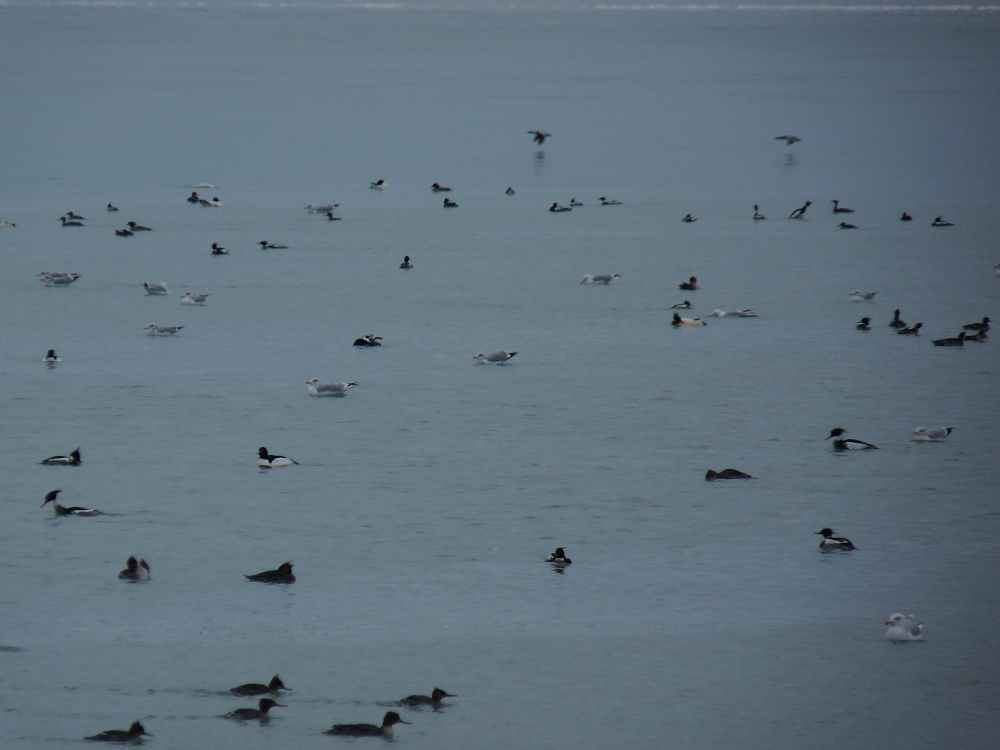
Red-breasted and Common Mergansers and Herring Gulls. February 2021. (click to see the larger version)
As I write this post in mid-February 2021, Chicago is experiencing a stretch of unseasonably cold late winter weather. Most of Lake Michigan at Montrose is frozen to the horizon, with small areas of open water at the harbor mouth and off the fishing pier. From a birding point of view, checking these open areas is worthwhile since they tend to attract and concentrate ducks and gulls. In addition to the expected Common and Red-breasted Mergansers and Common Goldeneye, we’ve seen Long-tailed Duck and Black Scoter. According to NOAA, Lake Michigan has about 27% ice coverage, a far cry from 93% in 2014. If the unseasonably cold weather persists, the 27% will no doubt increase.
Early December 2020 – Winter is Upon Us
Avian activity has slowed considerably at Montrose. I’ve been topping out at about 20 species on my two hour morning visits since December 1. Things won’t improve much until late February when spring migration begins, and if the harbor and Lake Michigan freeze it will only get worse. Common Mergansers and Common Goldeneye, the two main wintering ducks, haven’t arrived yet in numbers because of the mild weather we’ve been experiencing. They’ll start to show up when it gets seriously cold. The big flocks of Red-breasted Mergansers from November have pulled out. Lake Michigan now feels lifeless and empty without them. Common Redpolls are still around but for how long is anyone’s guess. Most of the sparrows from mid-November have left, with only Dark-eyed Juncos and American Tree Sparrows remaining. Despite the doldrums, we have had a few interesting species. An adult light morph Snow Goose has been keeping company with Canada Geese. Scan any group of Canada Geese if you’re looking for it. You could also find other uncommon geese like Cackling or Greater White-fronted by looking through the Canadas. An American Black Duck, an unusual bird for Montrose, has been with Mallards, usually in the harbor. On December 4 I saw an immature Great Black-backed Gull on the public beach. As always, check the Montrose Point eBird Hotspot for current sightings.
Suggestions for Winter Birding at Montrose
I have some suggestions for winter birding at Montrose. As long as the harbor remains open it’s worth checking for waterfowl, gulls, and grebes. Long-tailed Ducks, scoters, Red-necked and Western Grebes, and several unusual gulls have been seen in the harbor in early winter. Once the harbor freezes over this won’t be an option. The hawthorns near the restroom building on the south side of the harbor are full of berries as of early December. On December 4 I had American Robins, European Starlings, and a few House Finches gorging on these berries, and something rare like a Pine Grosbeak or Bohemian Waxwing is possible while the berry supply lasts. Finally, 2020 isn’t shaping up to be a flight year for Snowy Owls but a few could still show up. The best places to look for them are the beach, Dunes, and fishing pier.
Red-breasted Merganser, June 24, 2014
A female Red-breasted Merganser appears to be over summering at Montrose. She’s been seen near the fishhook pier and inside the boat harbor, where I saw and photographed her today.
I also saw my first juvenile Northern Rough-winged Swallows of the season today. Northern Rough-winged Swallows nest on the fishhook pier and can often be seen hawking insects over the dunes. They, along with other swallows, like to perch on the yellow rope that cordons off the protected areas of the dunes.
June 18, 2014
The Curve-billed Thrasher was obviously the big story at Montrose today but there were a few other birds of interest. Late this afternoon I had 6 Semipalmated and 1 White-rumped Sandpiper inside the protected area at the east end of the beach. This might be the latest spring White-rumped I’ve ever seen. Also, the continuing female Red-breasted Merganser was inside the harbor.


